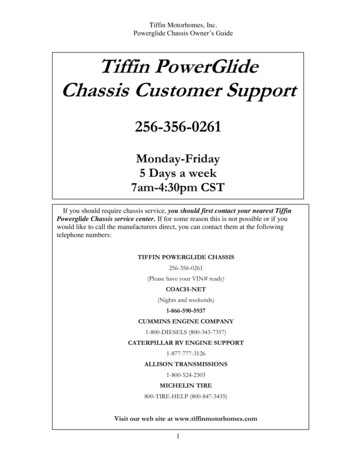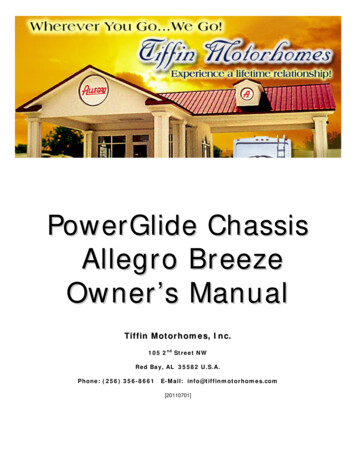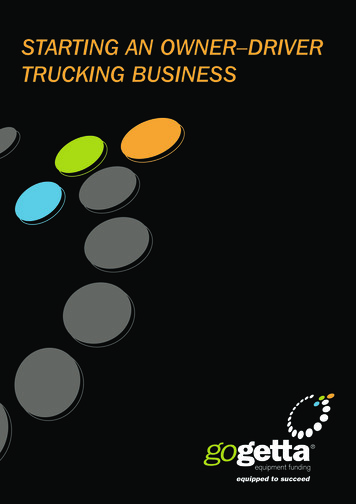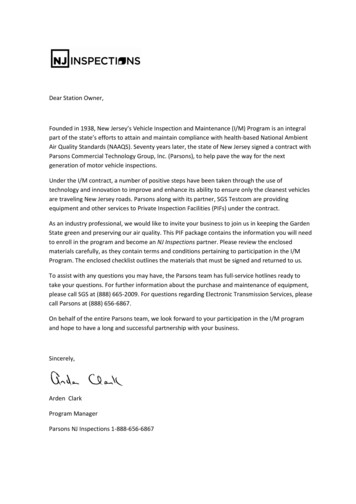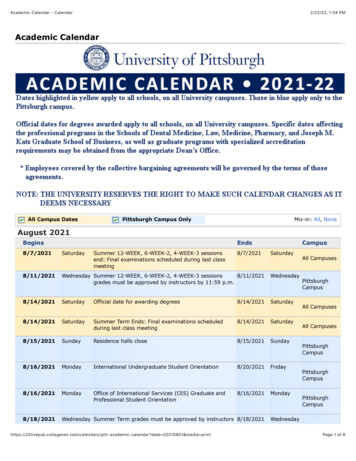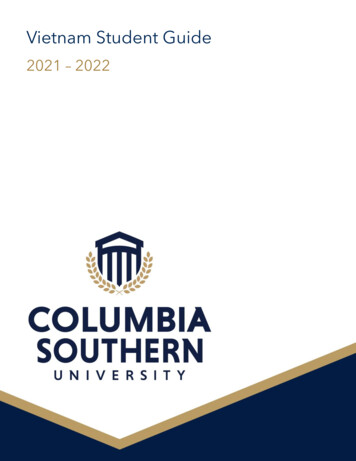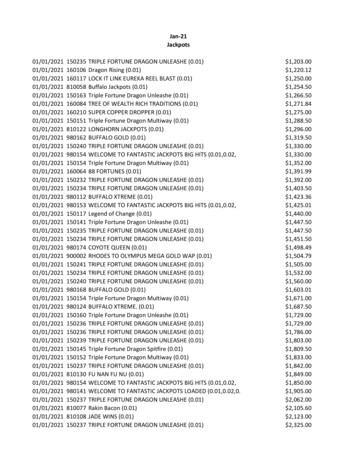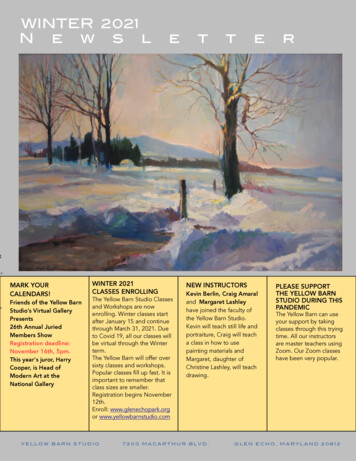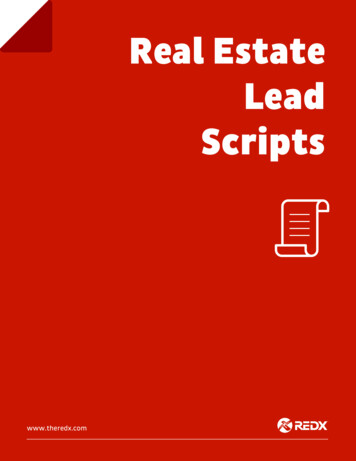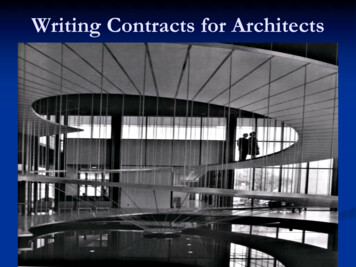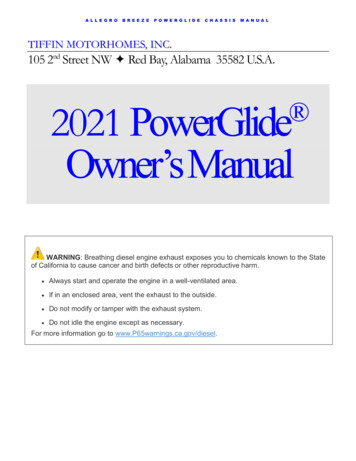
Transcription
A L L E G R OB R E E Z EP O W E R G L I D EC H A S S I SM A N U A LTIFFIN MOTORHOMES, INC.105 2nd Street NW Red Bay, Alabama 35582 U.S.A.2021 PowerGlideOwner’s Manual WARNING: Breathing diesel engine exhaust exposes you to chemicals known to the Stateof California to cause cancer and birth defects or other reproductive harm. Always start and operate the engine in a well-ventilated area. If in an enclosed area, vent the exhaust to the outside. Do not modify or tamper with the exhaust system. Do not idle the engine except as necessary.For more information go to www.P65warnings.ca.gov/diesel.
A L L E G R OB R E E Z EP O W E R G L I D EC H A S S I SM A N U A LTIFFIN MOTORHOMES, INC.Allegro Breeze Chassis Owner’s Manual Tiffin Motorhomes, Inc.105 2nd Street NW, Red Bay, AL 35582 U.S.A.Telephone 256.356.8661 Facsimile 256.356.8219E-Mail: info@tiffinmotorhomes.comDISCLAIMERMany of the features and appliances described in this manual may or may not be reflected in theactual motor home purchased, depending on the options and models selected by the motorhomeowner. All items, materials, instructions, and guidance described in this manual are as accurateas possible at the time of printing. However, because of Tiffin Motorhomes’ ongoing anddedicated commitment to excellence, improvement of Tiffin motorhomes is a continuing process.Consequently, Tiffin Motorhomes reserves the right to make substitutions and improvements inits makes and models of motorhomes without prior notification. Substitutions of comparable orbetter materials, finishes, appliances, instrumentation, and instruction may be made at any timeit is deemed prudent to provide the customer with the best possible motorhome meeting thecustomer’s requirements.Copyright 2020 by Tiffin Motorhomes, Inc. -- all rights reservedPrinted in the United States of America: Third U.S. Printing: 2020[20200416]
Tiffin Allegro Breeze - PowerGlide ChassisCustomer Support256-356-0261Monday-Friday7 a.m. - 4:30 p.m. CSTIf you should require chassis service, you should first contact your nearest TiffinPowerglide Chassis service center. Usehttps://tiffinmotorhomes.com/locate dealer/map.php to find and authorized warrantyservice facility. If for some reason this is not possible or if you would like to call themanufacturers direct, you can contact them at the following telephone numbers:TIFFIN POWERGLIDE CHASSIS256-356-0261(Please have your VIN# ready)SAFE RIDE(Nights and weekends)1-877-276-0619CUMMINS ENGINE COMPANY1-800-CUMMINS (286-6467)ALLISON TRANSMISSIONS1-800-524-2303MICHELIN TIRE800-TIRE-HELP (800-847-3435)Visit our website at www.tiffinmotorhomes.comii
A L L E G R OB R E E Z EP O W E R G L I D EC H A S S I SM A N U A LTable of ContentsChapter 1Chapter 4Tire CareEngineTire Care1-2EPA Mandates4-3Correct Tire Pressure1-3ATS Warning Lamps4-4DPF Maintenance4-4Aftertreatment Operation4-5Engine Indicator Lamps4-7Emissions and Fuel EfficiencyCompliance1-4Chapter 2Brake SystemEngine Starting4-11Cold Weather Starting4-12Engine Braking4-12Cruise Control4-13Brake System2-2Engine Shutdown4-14Compressed Air System2-3Diagnostic Fault Codes4-14Air Dryer2-4Towing4-15Chapter 5Allison Transmission OperationChapter 3MaintenanceScheduled Maintenance Chart3-2Fluids3-5Lubrication Points3-8Maintenance Parts3-12Tiffin Assistance3-13Driving Considerations5-2Fluid Level Check5-3Chapter 6Instruments & ControlsiiSafety4Overview5Gauge Quick Reference8Navigation9
A L L E G R OB R E E Z EP O W E R G L I D EIndicators10Main Gauges14Selectable Display18Additional Displays23Leveling24Alarm Messages27Menu Map32TPMS36Diagnostics40Chapter 7LevelingSafety Instructions4Overview5Operation6Leveling8System Commands17Status Messages20Chapter 8Pre-Trip InspectionsPre-Trip Inspection8-2Chapter 9WarrantyWarranty9-2Chapter 10Allegro Owner’s ClubAllegro Club10-2iiiC H A S S I SM A N U A L
T I R EC A R EChapter1TIRE CARE1-1
T I R EC A R ETiffin Motorhomes: “Wherever you go we go”TIRE CARE What is the most important component of tire care? TIRE PRESSUREo Why?Improved RideImproved Tire WearImproved Road HandlingImproved BrakingTire CareMaintaining the proper tire inflation pressure is the most important thing you can do to maximize the life ofyour tires. An under-inflated tire can build up excessive heat that may go beyond the prescribed limits ofendurance of the rubber and the radial cords. Over-inflation will reduce the tire’s footprint on the road,reducing traction, braking capacity, and the handling of your vehicle. An over-inflated tire will also cause a harshride, uneven tire wear, and will be more susceptible to impact damage.Keep in mind that the pressure rating on the side wall of your tire is the maximum pressure for that tire. This isnot necessarily the correct pressure for the tires when installed on your vehicle. Maintaining the correct tirepressure for your vehicle’s loaded weight is extremely important and must be a part of regular vehicle maintenance.1-2
T I R EC A R ECorrect Tire Pressure How to determine the correct pressure Weigh each wheel position Set tire pressure according to chart* This Chart Shows Cold Inflation Pressures265/70 R19.5 XZE2 Load per AxlePSI 65707580859095100105110KPA 402,360To determine the correct air pressure for your tires, load your motor home as you would normally travel,including water and fuel. Go to a truck scale as found at most major truck stops and weigh each wheelposition independently, with driver and passenger(s) in the vehicle as described in the Michelin RecreationalVehicle Tire Guide (MWL43146 Rev. 03/12) to determine the correct air pressure for the weight on eachwheel position. Then use the charts in the guide and adjust the pressure accordingly when the tires are cool orhave not been driven for more than one mile. You may call 1-800-847-3435 for a copy of the MichelinRecreational Vehicle Tire Guide , or visit: -tables/#/NOTE: Never reduce the air pressure in a hot tire.REMEMBER: For control of your RV, it is critical that the tire pressure be the same on both sides of the axle.1-3
T I R EC A R EEmissions and Fuel EfficiencyComplianceYour chassis was designed, and built, with components including, but not limited to, low rolling resistance tiresspecifically designed and manufactured to exacting standards for regulatory fuel efficiency and greenhouse gasemissions compliance. The vehicle owner is responsible for being sure these components are replaced withthe same or equivalent components that maintain compliance with federal and local regulations.For help with determining tires that are the same or equal in regards to rolling resistance for maintainingcompliance with the regulatory standards, please contact Michelin at 1-800-947-3435.1-4
B R A K ES Y S T E MChapter2Brake System2-1
B R A K ES Y S T E MBrake SystemFigure 2-1: Rear Brakes Front brakes are air applied disc Rear brakes (Figure 2-1) double as parking brake -Park brakes are spring applied-Two large 15 x 8.625” drum brakes-Park brake remains applied even if air pressure is lostIf air pressure is lost- A buzzer and warning lamp will alert youChassis is equipped with automatic slack adjusters (Figure 2-2)-No brake adjustment requiredFigure 2-2: Automatic Slack AdjusterThe rear brakes on the PowerGlide chassis are also used as the parking brakes. This provides you the holdingpower of two large drum brakes to prevent your coach from rolling, even when fully loaded on a 20% grade.A decrease in air pressure will not cause an immediate loss of brakes. If a leak develops in the air system whiledriving, at approximately 60 to 65 PSI you will be alerted via a light on the instrument panel, and an audiblealarm will sound. As you apply the brakes, the air supply holding the park brakes in the released position will2-2
B R A K ES Y S T E Mgradually be depleted. When fully depleted, approximately 40 PSI to 45 PSI, the rear brakes will set. This allowsyou sufficient time to pull over to the side of the road.NOTE: The rear brakes have dual chambers – one for the service brakes and one for the park brake. Theservice brakes are air applied and spring released. The park brake is spring applied and air released.The brake system is equipped with automatic slack adjusters that avoid the need to manually adjust your brakes.Each time you step on the brake pedal, if adjustment is needed, the adjusters will take up the slack.Compressed Air SystemTank DrainsFigure 2-3: Tank DrainsThe compressed air system is comprised of two air storage tanks. The primary tank stores and supplies air forthe rear brakes, the secondary tank stores and supplies air for the front brakes.When air is compressed it becomes hot. As it cools condensed moisture forms in the system. The air system isequipped with an air dryer to remove most of this moisture. The dryer has an automatic moisture ejector thatreleases the trapped moisture back into the atmosphere. However, some moisture will form in the systembeyond the dryer, and make its way into the storage tanks. As moisture collects in the primary and secondarytanks, it displaces the area needed for air storage, thus requiring that the tanks be drained periodically.2-3
B R A K ES Y S T E MThe air system is equipped with air tank drains conveniently located in the left rear storage compartment(Figure 2-3). There is one drain for the primary tank and one for the secondary tank. These drains should beopened daily for a few seconds to remove any moisture trapped in the tanks.Air DryerFigure 2-4: Parker Air DryerThe Tiffin PowerGlide chassis air brake system features a Parker air dryer (Figure 2-4), which removes thecondensed moisture from compressed air. The air dryer is equipped with a desiccant cartridge that needs to bechanged every 36 months. The dryer is located on the driver’s side behind the compartment that holds the a/ccondenser and air tanks.WarningAir tanks should be bled of all pressure any time you perform work on the air system.2-4
M A I N T E N A N C EChapter3Maintenance3-1
M A I N T E N A N C EScheduled MaintenanceSERVICE INTERVAL(Miles x 1,000)Daily5101520Required Fluids, Lubricants, and ProceduresAir System:Air DryerXInspect for leaks and blockage of purge valve (9)Air IntakeXInspect for blockage at intake screen on rear capAir FilterXCheck restriction indicator - replace filter as needed (6)Primary Air Tank ReservoirXDrain condensation dailySecondary Air Tank ReservoirXDrain condensation dailyBrake Systems:ABS SensorsXClean sensors & adjust into hub rings. (1)Brake Pads, Rotors, Shoes & DrumsXInspect pads, shoes, rotors & drums for wear and cracks. (1)Slack AdjustersXInspect slack adjuster for proper adjustment & grease.Brake Hoses/Whips, Front & RearXInspect for leaks, & cracking.A/C Condenser FinsXInspect for blockage and wash clean every 10k or as neededCharge Air Cooler FinsXInspect for blockage and wash clean every 10k or as neededCooling Systems:Fan & Fan ShroudXRadiator Fins/GrillInspect for cracks.XRadiator Hoses & PipesInspect for blockage and wash clean every 10k or as neededXInspect for kinks, chaffing wear and leaks.Coolant LevelXCheck for correct level in sight glassCoolant LeaksXInspect for visual signs of coolant on the groundCoolant TestingXTest coolant for freeze protection and inhibitors (10) (11)Rear Electrical CompartmentXCheck for loose fuses and cablesFront Electrical CompartmentXCheck for loose fuses and cablesGenerator CablesXCheck for loose red & black cables connected to generatorElectrical Systems:Alternator BeltBatteriesXCheck for correct tension and wearXCheck for loose lugs / remove any corrosion3-2
M A I N T E N A N C EScheduled MaintenanceSERVICE INTERVAL(Miles x 1,000)Daily5101520Required Fluids, Lubricants, and ProceduresEngine Systems:Drive Belt ConditionXEngine Oil FilterEngine Oil LevelXReplace engine oil filter per engine manual (1)XCheck level dailyEngine OilExhaust & AftertreatmentInspect belt condition for cracks or other damage. Replace as necessary.XChange engine oil per engine manual (1)XInspect for signs of leakage, rust and pinholes.Diesel FuelAlways use ultra-low sulfur fuel onlyFuel Tank Vent LinesXFuel Tank & LinesXInspect for "P" traps that may cause air locks and slow fillingInspect for leaks around fuel inlet nipples and hoses.Engine CoolantReplace coolant that has been diluted with water or non-compatible coolant (11)Stage 1 Fuel FilterXReplace fuel filter per engine manual (8)Stage 2 Fuel FilterXReplace fuel filter per engine manual (8)Crankcase Ventilation FilterReplace at 75,000 milesSteering Systems:Steering Gear ArmXInspect for looseness.Steering GearXInspect mount bolts for looseness & hydraulic hoses for leaks.Steering Gear PumpXInspect for hydraulic hose leaks at fittings.Steering Shaft U-Joints & Pinch BoltsXInspect for loose fasteners & lube bearings w/NGLI #2.Steering Shaft BootXInspect for clearance between boot & shaftSuspension & Axles:Coach AlignmentXAlign coach as needed (4)Front Ride Height AdjustXInspect to make sure ride height is within specificationsRear Ride Height AdjustXInspect to make sure ride height is within specificationsRide Height Valve LinkagesXGrease linkage grommets w/D.A. Stewart Aqualube.Air Suspension BagsXInspect for leaks at fittings and inspect bags for leaks or cracksFront Axle BearingsXCheck fluid level through sight window, if low, repair leaks as necessary (7)Front Axle Tie Rods - InspectXInspect for loosenessFront Axle Tie / Relay Rods - LubricateXLubricate W/NGLI # 2 greaseFront Axle Idler ArmXLubricate W/NGLI #2 greaseFront & Rear ShocksXInspect for leaks on shock tube, replace as needed3-3
M A I N T E N A N C EScheduled MaintenanceSERVICE INTERVAL (Miles x 1,000)Daily5101520Required Fluids, Lubricants, and ProceduresSuspension & Axles:Rear Axle LubeXCheck fluid level & Inspect for leaks. Use synthetic oil only 75W90 (3)Wheel Lug TorqueXRe-torque all wheel nuts – Torque 450-500 ft. lbs. (2)Automatic Slack AdjustersXLubricate W/NGLI #2 greaseSlack Adjuster Cam ShaftsXLubricate W/NGLI #2 greaseSlack Adjuster Clevis PinsXInspect for wear in clevis pin and cotter pins. Replace as necessaryXInspect u-joints & straps for loose bolts & wear, lubricate w/NGLI #2 greaseTransmission & Driveline:Drive ShaftTransmission FluidReplace fluid at 150,000 miles or 48 months whichever occurs first. (5)Transmission FiltersReplace filters at 50,000 miles or 24 months whichever occurs first. (5)(1) Replace / inspect at stated mileage interval or every 12 months whichever occurs first(2) Re-torque all wheel nuts after the first 100 miles, then every 10K miles thereafter.(3) Factory filled with synthetic oil. Do not mix with mineral oils. Change oil every 3 years or 50,000 miles whichever occurs first(4) For best tire life and handling, alignment of front axle is recommended every 25K miles.(5) Factory filled with an Allison approved TES-295 fluid. To maintain these service intervals use only Allison approved TES-295 fluids(6) Replace filter when indicator shows 25 inches or every 12 months whichever occurs first.(7) Factory filled with 80W-90 mineral oil. Do not mix with synthetic oils. Change hub oil every 3 years or 50,000 miles whichever occurs first(8) Replace at stated mileage interval or every 12 months whichever occurs first.(9) Replace desiccant cartridge every 36 months.(10) Check coolant for freeze protection and inhibitors every 5000 miles or twice annually.(11) Drain, flush, and replace the engine coolant every 5 years.3-4
M A I N T E N A N C EFluidsEngine OilThe Cummins ISB engine in your coach was factory filled with Valvoline SAE 10W-30 motor oil. A florescentdye was added to the oil at the factory which will give the oil a red tint. This dye is used by Cummins to helpdetect oil leaks during engine testing. The dye does not affect the performance of the factory fill oil.The primary oil recommendation for the ISB engine is a high-quality SAE 10W-30 oil with API classificationCJ-4 that meets CES-20081 standards. If the engine is to be consistently operated in extreme coldtemperatures, -15 C (5 F), an SAE 5W-40 full synthetic oil is recommended.Cummins does not recommend special break-in oils for the ISB engine. The factory fill oil can be run until thefirst oil change interval is reached.Cummins does not recommend the use of aftermarket oil additives in the ISB engine. High-quality 10W-30engine oils with API classification CJ-4 meeting CES-20081 standards are precisely blended with the necessaryadditives. Additional additives are not necessary to enhance the oil performance.Please refer to your Cummins ISB Owner’s Manual for more details on engine oils, and other enginemaintenance.Engine CoolantThe engine cooling system in your coach was factory filled with Old World Final Charge Global, Nitrite-FreeCoolant. Old World Final Charge Global is a fully formulated, organic acid technology (OAT) coolantdesigned to protect all metals within the cooling system.Do not mix or dilute the coolant in your coach with water, or other non-compatible coolants. If you need totop off your cooling system use only Old World Final Charge Global 50/50 premixed coolant. If the coolantdoes become diluted with water, or another non-compatible coolant a complete drain, flush, and refill of thecooling system is required.Test the coolant in your coach for freeze protections, and inhibitors every 5000 miles, or at least twice annually.Test strips can be purchased from Old World Industries or one of its distributors.The engine coolant in your coach should be replaced every 5 years. Drain, flush and refill with new coolant.Be sure to use a coolant that meets are exceeds Cummins Engineering Standard, CES-14636. Please refer toyour Cummins ISB Owner’s Manual for more details on the required coolant specifications.3-5
M A I N T E N A N C EEngine Coolant (cont.)IMPORTANT! When refilling the cooling system follow these instructions:1)2)3)4)5)6)Open petcock at the top of the air compressorFill radiator through the surge tank (5 GPM max)Close petcock on air compressor when it begins to flow a steady stream of coolantContinue to fill the surge tank until coolant is visible halfway up the sight glassStart and run engine at idle for 10 seconds, and then at high idle for one minuteReturn engine to idle and top off surge tank until coolant is visible halfway up the sightglassDiesel Exhaust Fluid (DEF)DEF (diesel exhaust fluid) is used to reduce the NOx (nitrogen oxides) emissions from your engine exhaustsystem. DEF is non-flammable, non-toxic, and non-polluting. DEF can be corrosive to certain materials. IfDEF is spilled rinse and clean the area immediately with clear water.It is recommended that you only use DEF certified by the American Petroleum Institute (API) in your vehicle.Look for this symbol on the container, or dispensing system to identify the fluid has been certified by the API.DEF has a limited shelf life. Normal shelf life is around 18 months if stored in a sealed container attemperatures between 23 F and 77 F. DEF should not be stored in direct sunlight as this will reduce the shelflife of the product. If your coach is in storage for a period of 6 months or longer you should have thecondition of the DEF tested before use. Testing should be done using a DEF refractometer. The DEF shouldshow 32.5% Urea concentration, /- 1.5%. If the DEF test outside of this parameter the tank should bedrained, flushed with distilled water, and filled with new DEF.DEF consumption will vary depending on your driving habits, and operating conditions. Generaly DEFconsumption will be 2 to 4 gallons for every 100 gallons of diesel fuel burned.DEF freezes around 12 F. The DEF system on your vehicle is designed to accommodate this condition anddoes not require any intervention from the operator.NEVER add anything other than new or known good DEF to the tank. If the tank is accidently contaminatedby another fluid the tank should be drained, flushed with distilled water, and filled with new DEF.3-6
M A I N T E N A N C EDifferential OilThe differential in your coach was factory filled with Shell Spirax 75W-90 full synthetic lubricant. The fluidlevel should be checked every 10K miles. If make-up oil is required use only full synthetic 75W-90 lubricants.Never mix mineral oils with synthetic lubricants.The differential oil should be changed every 3 years or 50,000 miles, whichever occurs first.Transmission FluidThe transmission in your coach was factory filled with Shell Spirax S6 A295 synthetic fluid. Spirax S6 A295 isan Allison approved TES-295 fluid. Allison approved TES-295 fluids extend both the service intervals, and thewarranty for your transmission. Continued use of TES-295 fluid provides extended warranty coverage up to 5years or 200,000 miles whichever occurs first.Transmission fluid should be checked on a regular basis. It is recommended to check fluid at the end of theday when the transmission is at full operating temperature. Fluid should be checked with the park brake set,the engine running at idle, the transmission in neutral, and the transmission temperature above 140 F.Transmissions do not consume fluid. If you find the need to regularly add fluid to your transmission a leak hasdeveloped, and you should seek service from an Allison authorized dealer as soon as possible.Change the transmission filter every 24 months or 50,000 miles whichever occurs first. Change thetransmission fluid every 48 months or 150,000 miles whichever occurs first.Please refer to your Allison Transmission Operators Manual for additional information on transmission fluids,and other transmission maintenance.3-7
M A I N T E N A N C ELubrication Points(Front)3-8
M A I N T E N A N C ELubrication Points3-9
M A I N T E N A N C ELubrication Points(Rear)3-10
M A I N T E N A N C ELubrication PointsComponentsRemarksTotalUpper / Lower SteeringShaftsThree grease fittings; oneat each u-joint, and oneat slip joint.6Tie RodsOne grease fitting per tierod. Two on left and twoon right tie rods.4Main DriveshaftAutomatic SlackAdjustersBrake Camshaft BracketsThree grease fittings;lubricate both universaljoints & slip joint.One grease fitting oneach slack adjuster. Oneadjuster at each wheelend.One grease fitting oneach bracket; Pump ingrease until it appears atthe slack adjuster end ofthe bracket. One at eachwheel end.344Relay RodOne grease fitting oneach rod end.2Front Suspension IdlerArmOne on idler armhousing13-11
M A I N T E N A N C EMaintenance PartsEngine Oil FilterCummins part # LF3970Tiffin part # N/AEngine Stage 1 Fuel FilterCummins part # FS1098Tiffin part # N/AEngine Stage 2 Fuel FilterCummins part # FF63009Tiffin part # 5059830Engine Air FilterParker / Racor # 062891001Tiffin Part # 5059543Transmission FilterAllison part #29539579Tiffin Part # 5018863Serpentine BeltCummins part # 3978294Tiffin Part # N/A3-12
M A I N T E N A N C EFor assistance with yourTiffin PowerGlide ChassisPlease contact one of the followingChassis Specialists at Tiffin Motorhomes, Inc.256-356-8661ServiceBilly Payne, extension 3862ServiceRicky Brown, extension 3861PartsHeath Thorne, extension 3860Mechanical EngineeringCorbette Davis, extension 2125Electrical EngineeringChris Stuzik, extension 2363Plant ManagerGary Harris, extension 2288Please have your Chassis VIN # ready when you call.3-13
M A I N T E N A N C E3-14
C U M M I N SE N G I N E SChapter4Cummins ISB EngineEngine ModelAdvertised HP (kW) @ RPMPeak Torque LB-FT (N M) @ RPMISB6.7 340340 (254) @ 2600700 (949) @ 16004-2
C U M M I N SE N G I N E SEPA MandatesThe Environmental Protection Agency (EPA) mandates that all engines built after December 31, 2009 mustreduce the level of emissions exhausted by the engine to the following levels.Nitrous Oxides (NOx) – 0.2 g/bhp-hrParticulate Matter (PM)- .01 g/bhp-hrTo meet EPA guidelines, diesel engines installed in Tiffin Motorhomes PowerGlide chassis for domicilein Canada and the USA use an after treatment system (ATS) with a diesel particulate filter (DPF)to reduceparticulate matter, and selective catalytic reduction (SCR) technology to reduce NOx downstream of theengine.NoticeUsing non-specification fluids can result in serious damage to the ATS. It is extremely important that thefollowing guidelines be met for vehicles with EPA10 thru EPA2017 compliant engines, or damage mayoccur to the ATS, and the warranty may be compromised. Use "ultra-low sulfur diesel (ULSD)" with 15 ppm sulfur content or less. Do not use fuel blended with used engine lube oil or kerosene. Engine lube oil must have a sulfated ash level less than 1.0 wt %, currently referred to as CJ-4 oil. Use only API certified diesel exhaust fluid (DEF) in the DEF tank.The ATS is comprised of a diesel oxidation catalyst (DOC), and a diesel particulate filter (DPF). TheDPF traps soot particles, and exhaust heat converts the soot to ash in the DPF in a process calledregeneration (re-gen). The harder an engine works, the better it disposes of soot. When the engine isrunning under load and re-gen occurs without input, it is called passive re-gen. If the engine isn’t runninghot enough, the electronic controls may initiate an active re-gen, whereby extra fuel is injected into theexhaust stream before the DPF, to superheat the soot trapped in the filter and burn it to ash. Both typesof re-gen occur without driver input.Operating at reduced engine load will allow soot to accumulate in the DPF. When this occurs, the DPFlampilluminates, indicating that a re-gen must be performed, and the driver must bring the vehicleup to highway speed to increase the load. Driving at highway speeds for 20 minutes should allow for are-gen to take place, and turn off the DPF lamp.4-3
C U M M I N SE N G I N E SAfter the exhaust stream passes through the DPF, it flows through a second canister housing which is theSCR device. A controlled quantity of diesel exhaust fluid (DEF) is injected into the exhaust stream whereheat converts it to ammonia (NH3) gas. This mixture flows through the SCR device where the ammoniagas reacts with the NOx in the exhaust to produce harmless nitrogen (N2) and water vapor (H2O), whichthen exits out of the tailpipe.ATS Warning LampsWarning lamps in the driver’s message center alert you of situations with the after-treatment system. An illuminated DPF lamp indicates a re-gen is needed.Driving at highway speeds for 20minutes should correct this condition.o A blinking DPF lamp indicates the need for a re-gen is more urgent. Again, driving thevehicle at highway speeds for 20 minutes should correct this condition.o A blinking DPF lamp along with a check engine light indicates that the engine is unable toeffectively regenerate, and you should immediately seek service at the nearest CumminsAuthorized Dealer. An illuminated High Exhaust Temperature (HEST) lamp alerts the operator of elevated exhausttemperatures while the engine is performing an active re-gen.Do not operate, or park thevehicle near flammable objects while the HEST lamp is illuminated. An illuminated DEF warning lamp indicates that the DEF tank should be refilled at the nextopportunity.This light will illuminate when the tank level is at approximately 10%.o A blinking DEF warning lamp indicates the tank level has dropped to approximately 5%.o A blinking DEF lamp along with the check engine lamp indicates the tank level hasdropped to approximately 2.5%. A 25% reduction in engine torque will be applied withthis condition.o When the tank is empty the Stop Engine Light will be illuminated and the vehicle speedwill be limited to 5 MPH. Filling the tank with new DEF will remedy this condition.DPF MaintenanceEventually ash will accumulate in the DPF and the filter will require servicing. DPF servicing must beperformed by an authorized technician, following the engine manufacturer’s instructions. DPF cleaningwill be required at approximately 200,000 miles of service. A record must be maintained for warrantypurposes, which includes: Date of cleaning or replacement Vehicle mileage4-4
C U M M I N S E N G I N E SParticulate filter part number and serial numberAftertreatment OperationDiesel Particulate FilterSoot is composed of the partially burned particles of fuel that occur during normal engine operation(black smoke).Ash is composed of the partially burned particles of engine oil that occur during normal engine operation.Over time, both soot and ash accumulate in the DPF and must be removed. Soot is removed by aprocess called regeneration. Ash is removed by removing the DPF and cleaning it at specified intervals.A vehicle with an ATS has up to four additional indicator lamps on the dashboard. These additionallamps, along with the check engine lamp, alert the operator of the status of the ATS.Ultra low sulfur diesel fuel is required for an engine equipped with a DPF. If ultra low sulfur diesel is notused, the engine might not meet emissions regulations, and the DPF or DOC can be damaged.To maximize the maintenance intervals of the DPF, Cummins Inc. recommends the use of a lubricatingengine oil meeting Cummins Engineering Standard 20081. The use of oil meeting CES 20081 alsorequires the use of ultra low sulfur diesel fuel to maintain the specified oil drain interval without risk ofengine damage.RegenerationRegeneration is the process of converting the soot collected in the DPF into ash.Under some operating conditions, such as low speed, low load, or stop and go duty cycles, the enginemay not have enough opportunity to regenerate the DPF during normal vehicle operation. When
ALLEGRO BREEZE POWERGLIDE CHASSIS MANUAL TIFFIN MOTORHOMES, INC. Allegro Breeze Chassis Owner's Manual Tiffin Motorhomes, Inc. 105 2nd Street NW, Red Bay, AL 35582 U.S.A. Telephone 256.356.8661 Facsimile 256.356.8219 E-Mail: info@tiffinmotorhomes.com as possible at the time of printing.
